One Carolina Down
Comment via blog
Check Granny's letters of the day


|
Day 22: November 25, 2020 One Carolina Down Comment via blog Check Granny's letters of the day |
|
 
|
|
|


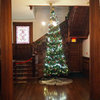
 I had not realized that a night at the Lookaway included breakfast, and
that held true even when I was the only guest. I imagine a full house sees
a more elaborate spread but eggs, muffin, juice, and coffee suited me just
fine. John then gave me a full tour. The main house was built in 1896 by
Walter Jackson. The addition containing my room was built in 1992 when the
whole place became a hotel. Even though they are separated by nearly a
century, the two match remarkably well. There are several fireplaces
throughout the house. Each is unique and most are trimmed in different
colored tile. The only item in the house that belonged to the original
occupants is the deer foot gun rack. The old radio comes from John's
family and he remembers listening to ball games and other programs on it
as a child.
I had not realized that a night at the Lookaway included breakfast, and
that held true even when I was the only guest. I imagine a full house sees
a more elaborate spread but eggs, muffin, juice, and coffee suited me just
fine. John then gave me a full tour. The main house was built in 1896 by
Walter Jackson. The addition containing my room was built in 1992 when the
whole place became a hotel. Even though they are separated by nearly a
century, the two match remarkably well. There are several fireplaces
throughout the house. Each is unique and most are trimmed in different
colored tile. The only item in the house that belonged to the original
occupants is the deer foot gun rack. The old radio comes from John's
family and he remembers listening to ball games and other programs on it
as a child.
|
|
|



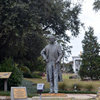
 The open space in front of the inn looks like it could be the front lawn
but it is a city park. I've photographed it before, and, just like James
Brown, I've always caught it ready for Christmas. Tis the season for Mr.
Moneybags to chase the hoop skirted damsel around the Tom Meriwether
monument. That monument is among the south's most controversial. Read one
side of the controversy
here. John told me that the city formed a committee to
deal with it but they were told at the forming that, because the state
legislature had placed the monument, removing it was not an option without
state involvement. The committee has recommended that explanatory signage
be placed at the marker. It will be really interesting to see what they
come up with.
The open space in front of the inn looks like it could be the front lawn
but it is a city park. I've photographed it before, and, just like James
Brown, I've always caught it ready for Christmas. Tis the season for Mr.
Moneybags to chase the hoop skirted damsel around the Tom Meriwether
monument. That monument is among the south's most controversial. Read one
side of the controversy
here. John told me that the city formed a committee to
deal with it but they were told at the forming that, because the state
legislature had placed the monument, removing it was not an option without
state involvement. The committee has recommended that explanatory signage
be placed at the marker. It will be really interesting to see what they
come up with.
The statue at the tip of the park is James U. Jackson, Walter's brother and identified as the founder of North Augusta. The story is that Walter won the more prominent location for his home by a cut of cards. James' even larger home is across the street. |
|
|
 Granny's only comment on South Carolina's capital was that they "Had
poor roads to Columbia and worse ones afterwards." In reaching a spot
to camp, they "pushed each other out of the mud holes and held the
cars up to keep them from falling over".
Granny's only comment on South Carolina's capital was that they "Had
poor roads to Columbia and worse ones afterwards." In reaching a spot
to camp, they "pushed each other out of the mud holes and held the
cars up to keep them from falling over".
|
|
|

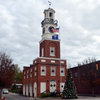
 In the morning, the last eleven miles to Winnsboro took three hours during
which they "pushed each other out of one hole into another."
Granny said nothing else about Winnsboro, but I had better roads and was
probably more inclined to look around. I found both the 1823
Fairfield County courthouse and the 1875 public market
and clock tower quite interesting. The clock is said to be
"the longest continuously running clock in the United States."
The arrowhead shaped sign on the building says
1833 but online information says the parts were ordered in 1837.
In the morning, the last eleven miles to Winnsboro took three hours during
which they "pushed each other out of one hole into another."
Granny said nothing else about Winnsboro, but I had better roads and was
probably more inclined to look around. I found both the 1823
Fairfield County courthouse and the 1875 public market
and clock tower quite interesting. The clock is said to be
"the longest continuously running clock in the United States."
The arrowhead shaped sign on the building says
1833 but online information says the parts were ordered in 1837.
|
|
|
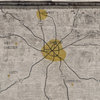
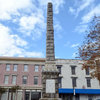
 Granny says the roads improved slightly after Winnsboro, but that they
"Went on low most of the way from there to Chester". On today's
roads, my continuously variable transmission varied continuously as far as
I know. Chester's Confederate Monument has the expected
text on the column but no mass produced
soldier standing at its top. It was about fifteen years old when Frank and
Gertrude passed by. Chester also has a mural showing that everywhere is
the center of somewhere.
Granny says the roads improved slightly after Winnsboro, but that they
"Went on low most of the way from there to Chester". On today's
roads, my continuously variable transmission varied continuously as far as
I know. Chester's Confederate Monument has the expected
text on the column but no mass produced
soldier standing at its top. It was about fifteen years old when Frank and
Gertrude passed by. Chester also has a mural showing that everywhere is
the center of somewhere.
|
|
|


 Granny mentions Lando in reference to a camping spot but I have no idea
whether either of this buildings existed at the time. I saw many
candidates for the "nice big house" they camped across from but
no clear winner. The third picture was taken beyond where their campsite
might have been and is included to show that I'm still following the old
road and that the automobile road is still following the railroad.
Granny mentions Lando in reference to a camping spot but I have no idea
whether either of this buildings existed at the time. I saw many
candidates for the "nice big house" they camped across from but
no clear winner. The third picture was taken beyond where their campsite
might have been and is included to show that I'm still following the old
road and that the automobile road is still following the railroad.
|
|
|
 Charlotte had some of the worst traffic I've encountered on this trip. The
presence the big race track may or may not have anything to do with that.
I took this picture only because I was stopped in traffic and able to snap
it over my shoulder.
Charlotte had some of the worst traffic I've encountered on this trip. The
presence the big race track may or may not have anything to do with that.
I took this picture only because I was stopped in traffic and able to snap
it over my shoulder.
|
|
|
| [Prev] [Site Home] [Trip Home] [Next] |